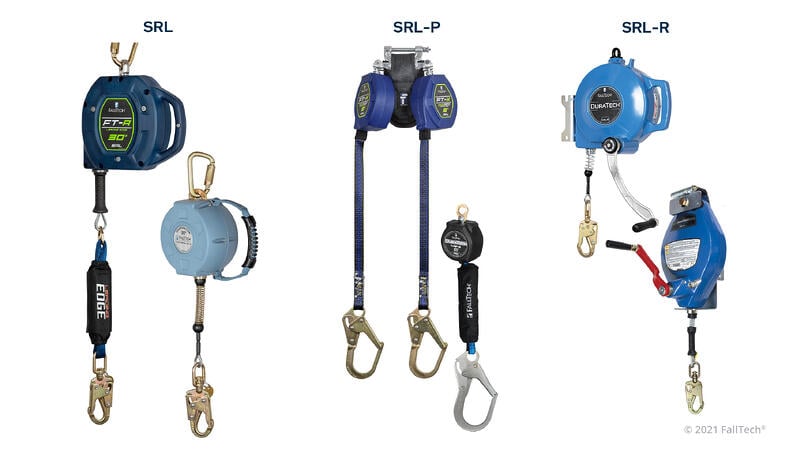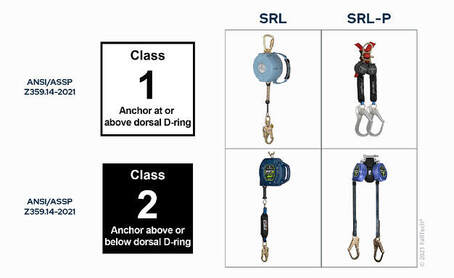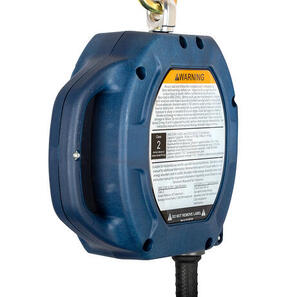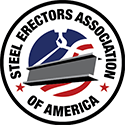ANSI Z359.14-2021: What You Should Know to Comply with the Updated Self-Retracting Devices Standard2/13/2023
What are the high-level changes that ANSI Z359.14-2021 addresses? On June 17, 2021, ANSI approved the new 2021 revision of Z359.14, Safety Requirements for Self-Retracting Devices (SRDs) for Personal Fall Arrest and Rescue Systems. This revision supersedes the 2014 version and goes into effect on August 1, 2023, which is an important date for ANSI compliance while using self-retracting devices. In the previous 2014 revision of Z359.14, SRDs were organized by type (SRL, SRL-R for devices with rescue/retrieval functions, or SRL-LE for leading edge capability) and class (Class A or Class B). The intent was to organize SRDs by features in "Type" and then by their overhead performance capability by "Class." At a high level, the 2021 changes to the ANSI Z359.14 standard are designed to:
What will be the new ANSI Z359.14-2021 SRD types and classes? Both types and classes were overhauled in 2021: "types" are SRL, SRL-P for personal devices meant to be installed on the user's full body harness, or SRL-R for devices with rescue/retrieval functions, and "classes" are Class 1 or Class 2. The SRD class is now applied to acceptable anchorage locations. Class 1 devices are suitable for at or above dorsal D-ring anchorage locations. Class 2 devices are suitable for above, at, or up to 5 feet below the dorsal D-ring anchorage locations AND must be leading edge rated. So, if your jobsite has edge exposures and you need a leading edge SRL or SRL-LE, you will be looking for a Class 2 device in compliance with ANSI/ASSP Z359.14-2021. With the type and class changes, Z359.14-2021 also introduced standard overhead performance criteria for all SRDs and standardized class labeling. Now, a worker will be able to quickly identify the suitable device for the hazards faced in their work zone. In the 2012 and 2014 revisions of Z359.14, overhead performance criteria were defined by SRD class: Class A or Class B. In 2021, overhead performance will be standardized across all SRDs. The performance requirements are summarized in the table below: What is the new ANSI Z359.14-2021 standardized labeling requirements? All ANSI/ASSP Z359.14-2021 compliant SRDs will have one of the markings below consistent with its class: In addition to the Class 1 and Class 2 standard labels, all Class 2 SRLs must include a full fall clearance table or diagram as part of the physical product and the user instruction manual. This provides critical clearance information directly on the product, where it is most easily accessible by the end user or Competent Person at the place and time of use. How will the testing of SRDs change with the new ANSI Z359.14-2021 requirements? The 2021 version of Z359.14 significantly expands the volume and severity of testing required to comply with the standard. Most of these changes are intended to improve safety factors and address specific known hazards or applications of SRDs. While testing the products mainly affects manufacturers and test labs, it's essential to understand how these changes may impact how these devices are deployed and used in the field by end users. Some of the significant changes include:
What is the compliance timeline for existing SRDs in use? ANSI/ASSP Z359.14-2021 goes into effect on August 1, 2023. For organizations or job sites that mandate ANSI compliance, all SRDs must be manufactured and marked as compliant with Z359.14-2021. Any SRDs marked as compliant with Z359.14-2014 or any previous revision will be considered out of compliance after August 1, 2023. FallTech recommends reaching out to your manufacturer to inquire how this standard change affects the SRDs that you are using now and plan your transition to 2021 compliant devices. I currently use a non-Leading Edge rated personal device in a below D-ring application. Will this still be allowed after August 1, 2023? This question has a two-part answer that depends on the ANSI compliance requirements of your organization or worksite. If strict ANSI compliance is required, then after August 1, 2023, only a Class 2 SRL-P will be appropriate for this application. If only OSHA compliance is mandated, then the existing device may continue to be used as approved by your Competent Person, Qualified Person, and/or Professional Engineer. You should use a five-foot set-back distance versus an anchorage at the leading edge because it equips your fall protection system to arrest the fall more quickly. If your anchorage is at the edge, the SRL will create additional freefall distance as it retracts. The pawl mechanism also needs the lifeline to pay out fast enough to engage. With a zero-foot set-back distance and below D-ring foot-level tie-off, it won’t activate until the worker has fallen below the device hanging beneath the leading edge, further delaying the arrest. With a five-foot set-back distance, this payout begins as soon as the user’s D-ring passes below the level of the anchorage. You can eliminate the extra freefall length, lower the MRFC, and create a safer working environment. Read the full article on FallTech's Safety Blog. This Safety Flash was contributed by FallTech, in cooperation with SEAA’s Safety Committee. It is designed to keep members informed about ongoing safety issues and to provide suggestions for reducing risk. Best practices are gathered from a variety of sources. They may be more or less stringent than individual corporate policies and are not intended to be an official recommendation from SEAA. Always get approval and direction from your company officers on any new practice or procedure as these best practices may not work for all situations.
Everyone benefits when a worker avoids injury. Submit your ideas for Safety Flash to [email protected]. Comments are closed.
|






 RSS Feed
RSS Feed
